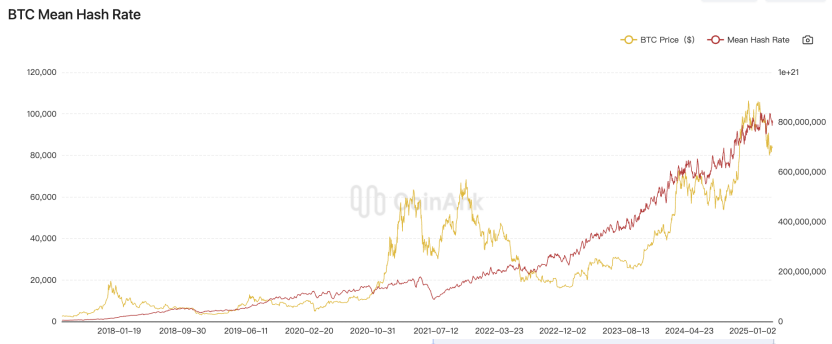Trump and Powell's Interest Rate Game Reignites a War of Words,BTC Hashrate Soars to New Historical Highs
Macroeconomic Interpretation: When Trump unleashed his fierce rhetoric of "fire Powell" on social media, he perhaps did not realize that his tweets were resonating in a peculiar harmony with the roar of Bitcoin mining machines. A recent Reuters survey shows that the U.S. economic growth forecast for 2025 has been downgraded from 2.2% to 1.4%, with the probability of recession climbing to a new high of 45% within the year. Amid this macroeconomic fog, Bitcoin's total network hashrate has defied the odds, breaking through the historical peak of 1000 EH/s, showcasing its stubborn vitality.
The Federal Reserve's interest rate dilemma has evidently become a catalyst for market sentiment. JPMorgan analysis points out that when gold ETFs see net inflows for three consecutive months, Bitcoin behaves like a passenger who missed the last train, caught in the indecision of Federal Reserve policies. Powell's speech doused cold water on the prospect of early rate cuts, yet Bitcoin's price stubbornly rebounded after a brief decline, seemingly dangerous but actually containing a rhythm. Data shows that even with the surge in hashrate leading to increased mining costs per coin, Bitcoin has firmly held the $81,000 mark, creating a peculiar ecosystem where "the harder miners struggle, the steadier the coin price," which can be regarded as the most hardcore survival philosophy in the crypto world.
The undercurrents in the options market add drama to the situation. $2.25 billion in crypto options are set to expire, with $1.98 billion in BTC options pinpointing the maximum pain at $82,000. This intricate digital game of strategy sees the market bulls and bears engaged in fierce confrontations. The TD Sequential indicator has timely signaled a buy, with market analysts suggesting that if the weekly chart breaks through $86,000, Bitcoin may achieve "to da moon." This indicator analysis and the resonance with the derivatives market are weaving a precise price prediction network.
Interestingly, historical data from Coinank shows that in the first quarter, the total crypto market cap evaporated by $633.5 billion, and the spot trading volume on centralized exchanges shrank by 16.3%, yet Bitcoin's market share has risen against the trend to a three-year high of 59.1%. This trend of "all coins returning to one" resembles a lighthouse shining in a dark forest. Even the traditional financial world has echoed this, with annual trading volume of stablecoins surpassing Visa's total payment volume for the first time. This milestone achievement seems to declare that crypto assets have transformed from marginal experiments into true financial infrastructure.
Bitcoin demonstrates astonishing ecological resilience. Miners are gritting their teeth to upgrade their equipment in the hashrate competition, derivatives traders are holding their breath for the options expiration moment, while macro traders are seeking opportunities amid the Federal Reserve's "dovish-hawkish symphony." When Trump criticizes the Federal Reserve for "acting too late," the crypto market has already completed countless long-short conversions through price fluctuations. This rapid iteration of market wisdom may be the ultimate code for Bitcoin's enduring dominance after 15 years of trials. As the old Wall Street saying goes: "When gold is a safe haven, Bitcoin is redefining safe haven."

BTC* Data* Analysis:
Coinank data shows that Bitcoin's total network hashrate first broke the 1,000 EH/s threshold on June 25, reaching a historical peak before retreating to 893 EH/s, with the average hashrate stabilizing at 888.85 EH/s over the past week. This technical milestone marks a leap in the network's resistance to attacks, but it also simultaneously raised the cost of production per unit hashrate to a historical high of $0.06 per TH/s, an increase of over 400% compared to the 2020 halving cycle.
We believe that the surge in hashrate may stem from multiple drivers: the technological breakthrough of third-generation mining machines achieving efficiency ratios exceeding 30 J/TH, North American mining companies utilizing seasonal migration strategies to take advantage of surplus hydropower, and the surge in hedging positions in the futures market leading to the financialization of hashrate. It is noteworthy that the current hashrate/price ratio has deviated from the historical average by two standard deviations, forming a typical "hashrate bubble" characteristic, which often signals that the mining sector is about to enter a deleveraging cycle. With the block reward reduced to 3.125 BTC post-halving, the proportion of electricity costs in unit output for small and medium miners has surpassed the 65% warning line.
For the crypto market, the unusual hashrate movements will trigger structural transmission: the Miner Position Index (MPI) has dropped to -0.87, indicating accumulated selling pressure that may suppress short-term price trends; North American listed mining companies are accelerating mergers and acquisitions of small mining sites, which will increase Bitcoin holding concentration and may give rise to new types of "hashrate derivatives" trading demand; the rising proportion of energy costs is forcing miners to turn to the options market for hedging, pushing the Bitcoin volatility surface to steepen. It is worth noting that the current recovery speed of the total network hashrate far exceeds the price increase, and this "hashrate premium" phenomenon may indicate that the market is preparing infrastructure in advance for potential institutional-level custody demand.
免责声明:本文章仅代表作者个人观点,不代表本平台的立场和观点。本文章仅供信息分享,不构成对任何人的任何投资建议。用户与作者之间的任何争议,与本平台无关。如网页中刊载的文章或图片涉及侵权,请提供相关的权利证明和身份证明发送邮件到support@aicoin.com,本平台相关工作人员将会进行核查。



